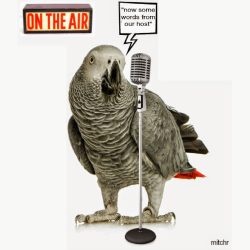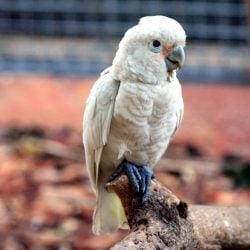
Installing the Aviator Flight Harness on a Parrot
Last Updated on by Mitch Rezman
The AVIATOR will improve your companion’s life experience for years to come. Take time to read, understand and follow instructions to ensure a positive experience. After reading the instructions, view the DVD version. Take your time; your efforts will be rewarded for a lifetime.
Do not show your companion the AVIATOR until you completely read and understand the introduction phase and installation process. Proper introduction of the harness to your bird is crucial to the success of The AVIATOR.
WARNING! Even though you can easily install The AVIATOR on most young birds it is important to follow the introductions. Sometimes young birds reluctantly allow a negative experience several times before they start to resist. At this point, it can become very difficult to change his mind. You may not know you made a mistake until it is too late. ONLY use the AVIATOR when your bird will be having a fun experience. If he is having fun, he will soon forget the harness and associate the AVIATOR as a positive experience. Do not put the harness on to get him used to wearing it. He will get used to wearing it while having a rewarding experience.
Following these very important steps will make it easy to install and use The AVIATOR.
First: You will need to groom your pet to accept two new behaviors that will facilitate the installation of the harness.
- Most birds allow the owner to pet under the wing but few birds experience their wings being held up when nothing else is going on. Birds normally do not like this position, they feel vulnerable to predators. Work with your pet until he allows you to hold his wing straight up for a few seconds. The exercise will progress faster if you gently pet his side when doing this exercise. As soon as he resists, let the wing down. Try this several times a day, a few seconds each time.
- Most birds never had anything placed over their head or around their neck. Practice wrapping your hand around his head and neck as though you are slipping the harness over his head. Using a toy that is familiar to your pet, approach his head touching and rubbing his beak, head and neck. Start with a favorite toy. Once he freely accepts the exercise try different toys.
Second: Do not attempt to put the AVIATOR on until he is familiar with it. Introduce your pet to the harness in the same way you would introduce a new toy.
This is easy for birds that look forward to new toy. For the others the slow approach is necessary and can take several days.
Suggestions:
- For difficult pets place the Aviator in sight and slowly move closer to your pet over a few days.
- Wrap a harness around your wrist or neck when you are with your companion.
- Lay the Aviator on a table or the top of the cage where the bird will end up standing or walking on it.
- As you play with your pet alternately lay the harness and leash on and around him.
- Hang the Aviator in the cage just as you would a new toy.
Installing the AviatorThe first few times you put on the AVIATOR will be a learning experience for you and your pet. The biggest inconvenience he is likely to experience is being pushed off balance while you learn to tighten the belt. If the experience begins to get frustrating for you or your pet, stop and try again later.
- Expand the belt of the harness, pulling leash #1 through slide #2 to a diameter large enough so that after you slip the belt #1 and collar #3 over the bird’s head, you can pull one wing through the space #4.
- Place the bird in front of you on a stable surface. Right-handed owners face your pet to your right.
- Orient harness assembly so the back of harness #5 is on top and the expanded belt loop #6 is directly in the front bird.
- Move harness assembly toward bird passing the belt loop #6 first, and the collar #3 second, over birds head until the belt is around the wings and the collar #3 rests on the neck.
- With the collar in place around the bird’s neck, pick up the left wing and pull through space #4 between belt and collar.
- Pull the belt to the right side of the bird until it is tight against the left side. Pull the right wing through space #7.
- Tighten the belt by pulling leash #1 through slide #2. Tighten until the belt is snug around the waist leaving just enough space to insert your index finger, between the bird and belt, on medium size bird. Space is necessary for the bird to breathe and for the slide to rotate from the chest to back.
Using the Aviator Harness and LeashMost birds need to learn two things about the Aviator.
First, he will catch his toes in the belt as he tries to grab it with his foot.
Second, he will need to learn the concept that there is a limit to the length of the leash. With a little help he will learn to get his toe unhooked and that, the leash has limits. The leash can be connected to a longer leash up to 40 feet depending on the size and flight capabilities of the bird.
We recommend The AVIATOR FLIGHT LINE or a retractable extended leash.
This style of leash limits the amount of slack where a bird can become entangled. Your bird can learn to fly in a circle on the end of the leash for extended distances. The direction of flight is determined by which side of the bird the slide is on. The slide should be on the side of the bird facing the handler when flying. This allows the belt to self-adjust as the bird moves. Never leave a bird unattended while wearing a harness!
Author Profile

Latest entries
 Bird & Parrot CareJune 20, 2025Understanding the Best Way to Use Prevue Pets Mimic Me Voice Trainer
Bird & Parrot CareJune 20, 2025Understanding the Best Way to Use Prevue Pets Mimic Me Voice Trainer Bird BehaviorJune 6, 2025How Do I Keep My Parrot From Dumping His Food Every Day?
Bird BehaviorJune 6, 2025How Do I Keep My Parrot From Dumping His Food Every Day? Birds & LightingMay 16, 2025I Am Seeking Clarity About Lighting for My Birds Cage
Birds & LightingMay 16, 2025I Am Seeking Clarity About Lighting for My Birds Cage Bird RescueApril 29, 2025How Do We Re-Home a 17 yr Goffin Cockatoo?
Bird RescueApril 29, 2025How Do We Re-Home a 17 yr Goffin Cockatoo?

